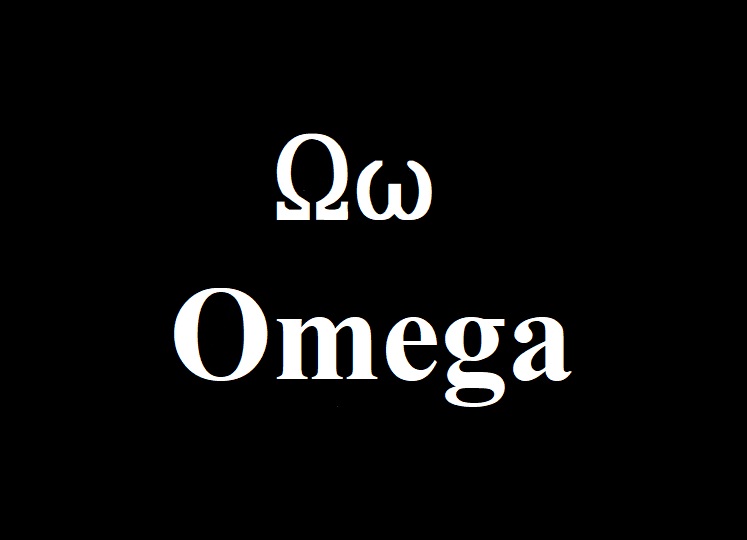
Constant Companion
By Anthony Casperson
9-9-17
A true companion is with you through all of life. The good parts and the bad. When events are going your way and when they aren’t. No matter what’s going on, a true companion is constant.
Stories of all kinds utilize this relationship. There are these two characters who are together so often that we think of them as a set rather than two individuals. Frodo and Sam. Han and Chewie. Jak and Daxter. Holmes and Watson. The Doctor and the TARDIS.
If you ever see one without the other, it seems wrong. You want to know why they are not together. Something big has to have happened in order for the pair not to be by each other’s side. This constant nature of their friendship makes the removal of one from the other feel unnatural.
As we return to looking at the “I Am” statements of Jesus in the writings of John, we find the first of two such statements in Revelation (the eighth overall statement). Jesus speaks of being the Alpha and Omega.
There are actually three separate locations in the book of Revelation where Jesus says “I am the Alpha and the Omega.” Though only the first time, found in Rev 1:8, is the full formula found in the Greek. The other, shorthanded mentions are found in Rev. 21:6 and 22:13.
The main idea of saying “Alpha and Omega” comes from the fact that these two letters are the first and the last letters of the Greek alphabet. Like saying “A to Z” in English. Jesus is the beginning and the end. It’s even elaborated this way in Rev. 21:6 and 22:13.
And I find it interesting that the first mention of Jesus being the Alpha and Omega is found near the beginning of the book, immediately after the greeting, and the last mention is found near the end of the book, just before the salutation. The statement itself is almost the beginning and the end.
But is there more to this statement than being in the beginning and the end, being eternal?
I think there is. In Rev 1, we see the greeting of John to the seven churches to whom he originally wrote. He reminds them in the greeting of Jesus’ return, the fullness of hope for we followers of Jesus. He ends verse 7 with “Amen” which denotes an end of thought. And verse 9 begins a brand new thought, namely John’s vision of which the book of Revelation largely consists.
So there’s verse 8 standing all by itself. “‘I am the Alpha and the Omega,’ says the Lord God, ‘who is and who was and who is to come, the Almighty.’” It’s a self-contained thought that helps us understand the rest of the book.
We are reminded of the constant nature of God found in Jesus, the second Person of the Trinity. Jesus is there, was there, and will always be there. But why is that important to the original audience and, by extension, us?
The book of Revelation is largely known for being some deeply mystical work of literature that gives us a glimpse of the future. Strange images of lambs with multiple eyes all around, beasts with many heads, and many other strange creatures make us think of the book as a spiritual acid trip. And arguments about the timing of events during the end times (often called “eschatology”) make us even more confused.
But the book is about two things: Jesus’ coming to judge the world, and how to live today in light of that fact.
John reminded his audience of Jesus’ return, then gives the “I Am” statement, follows that with the image of Jesus among the seven churches to whom John originally wrote. And then, in chapters 2-3, he records Jesus’ words to them.
Jesus is among his people. He stands in constant vigil over the representation of his people, the seven churches. Jesus and his followers are constant companions in the book of Revelation. They are inseparable. Jesus always is with his people, always was with his people, and always will be with his people.
But again, why is this important?
To each of the seven churches, Jesus speaks in a pattern. There’s an image of Jesus that the church needs to be reminded of. Then Jesus speaks of the good things happening in the church. A reminder of the trials that each church faces comes next. Notes for improvement follow. And each message ends with a promise specifically tailored to each church.
Notice that each church follows the pattern, but each also has specific things needed for each specific church. But one of the reasons that I believe Jesus has John write down these parts of the vision is the fact that Jesus is reminding them that in the midst of their various trials, Jesus remains a constant in their life. From beginning to end, he’s with them.
The church in Ephesus is dealing with false teachers. Those in Smyrna are being slandered and will soon be imprisoned. Some have been martyred in Pergamum and it doesn’t look like it’s going to end any time soon. The church in Thyatira are dealing with temptation in both a sexual nature and idolatry. Sardis has begun to atrophy from lack of vigilence. Those in Philadelphia face enemies with much more power than they have. And in Laodicea, apathy reigns, leaving the church so bland that it might as well be spit out.
The people in those churches all needed to be reminded that Jesus is with them. He’s their constant. In a world where so many different problems can arise, Jesus remains ready to be there. For there to be a time when Jesus is not seen in the midst of his followers, something big has to have happened. It’s just wrong.
“I am the Alpha and the Omega, who is and who was and who is to come, the Almighty. I am the Alpha and the Omega, the beginning and the end. To the thirsty I will give from the spring of the water of life without payment. I am the Alpha and the Omega, the first and the last, the beginning and the end.” When everything’s going wrong, Jesus is there.
By Anthony Casperson
9-9-17
A true companion is with you through all of life. The good parts and the bad. When events are going your way and when they aren’t. No matter what’s going on, a true companion is constant.
Stories of all kinds utilize this relationship. There are these two characters who are together so often that we think of them as a set rather than two individuals. Frodo and Sam. Han and Chewie. Jak and Daxter. Holmes and Watson. The Doctor and the TARDIS.
If you ever see one without the other, it seems wrong. You want to know why they are not together. Something big has to have happened in order for the pair not to be by each other’s side. This constant nature of their friendship makes the removal of one from the other feel unnatural.
As we return to looking at the “I Am” statements of Jesus in the writings of John, we find the first of two such statements in Revelation (the eighth overall statement). Jesus speaks of being the Alpha and Omega.
There are actually three separate locations in the book of Revelation where Jesus says “I am the Alpha and the Omega.” Though only the first time, found in Rev 1:8, is the full formula found in the Greek. The other, shorthanded mentions are found in Rev. 21:6 and 22:13.
The main idea of saying “Alpha and Omega” comes from the fact that these two letters are the first and the last letters of the Greek alphabet. Like saying “A to Z” in English. Jesus is the beginning and the end. It’s even elaborated this way in Rev. 21:6 and 22:13.
And I find it interesting that the first mention of Jesus being the Alpha and Omega is found near the beginning of the book, immediately after the greeting, and the last mention is found near the end of the book, just before the salutation. The statement itself is almost the beginning and the end.
But is there more to this statement than being in the beginning and the end, being eternal?
I think there is. In Rev 1, we see the greeting of John to the seven churches to whom he originally wrote. He reminds them in the greeting of Jesus’ return, the fullness of hope for we followers of Jesus. He ends verse 7 with “Amen” which denotes an end of thought. And verse 9 begins a brand new thought, namely John’s vision of which the book of Revelation largely consists.
So there’s verse 8 standing all by itself. “‘I am the Alpha and the Omega,’ says the Lord God, ‘who is and who was and who is to come, the Almighty.’” It’s a self-contained thought that helps us understand the rest of the book.
We are reminded of the constant nature of God found in Jesus, the second Person of the Trinity. Jesus is there, was there, and will always be there. But why is that important to the original audience and, by extension, us?
The book of Revelation is largely known for being some deeply mystical work of literature that gives us a glimpse of the future. Strange images of lambs with multiple eyes all around, beasts with many heads, and many other strange creatures make us think of the book as a spiritual acid trip. And arguments about the timing of events during the end times (often called “eschatology”) make us even more confused.
But the book is about two things: Jesus’ coming to judge the world, and how to live today in light of that fact.
John reminded his audience of Jesus’ return, then gives the “I Am” statement, follows that with the image of Jesus among the seven churches to whom John originally wrote. And then, in chapters 2-3, he records Jesus’ words to them.
Jesus is among his people. He stands in constant vigil over the representation of his people, the seven churches. Jesus and his followers are constant companions in the book of Revelation. They are inseparable. Jesus always is with his people, always was with his people, and always will be with his people.
But again, why is this important?
To each of the seven churches, Jesus speaks in a pattern. There’s an image of Jesus that the church needs to be reminded of. Then Jesus speaks of the good things happening in the church. A reminder of the trials that each church faces comes next. Notes for improvement follow. And each message ends with a promise specifically tailored to each church.
Notice that each church follows the pattern, but each also has specific things needed for each specific church. But one of the reasons that I believe Jesus has John write down these parts of the vision is the fact that Jesus is reminding them that in the midst of their various trials, Jesus remains a constant in their life. From beginning to end, he’s with them.
The church in Ephesus is dealing with false teachers. Those in Smyrna are being slandered and will soon be imprisoned. Some have been martyred in Pergamum and it doesn’t look like it’s going to end any time soon. The church in Thyatira are dealing with temptation in both a sexual nature and idolatry. Sardis has begun to atrophy from lack of vigilence. Those in Philadelphia face enemies with much more power than they have. And in Laodicea, apathy reigns, leaving the church so bland that it might as well be spit out.
The people in those churches all needed to be reminded that Jesus is with them. He’s their constant. In a world where so many different problems can arise, Jesus remains ready to be there. For there to be a time when Jesus is not seen in the midst of his followers, something big has to have happened. It’s just wrong.
“I am the Alpha and the Omega, who is and who was and who is to come, the Almighty. I am the Alpha and the Omega, the beginning and the end. To the thirsty I will give from the spring of the water of life without payment. I am the Alpha and the Omega, the first and the last, the beginning and the end.” When everything’s going wrong, Jesus is there.




